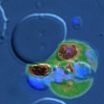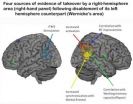(Press-News.org) Could probiotics help HIV patients?
Antiretroviral (ARV) drugs are the first line therapy for patients with HIV; however, ARV-treated, HIV-infected individuals still have a higher mortality rate than uninfected individuals. During the course of infection, HIV patients develop inflammation that damages the walls of the intestines, known as the gut mucosa, allowing intestinal microbes to escape and enter the blood stream to cause a life-threatening systemic infection. The health of the gut mucosa is significantly influenced by the complement of bacteria in the gut and there is mounting evidence that probiotic supplements benefit patients intestinal disorders, such as irritable bowel syndrome, C. difficile infection, and inflammatory bowel disease.
In this issue of the Journal of Clinical Investigation, researchers led by Jason Brenchley at the National Institute of Allergy and Infectious Disease, demonstrated that probiotic supplementation may also be beneficial for ARV-treated HIV patients. Brenchley and colleagues treated SIV-infected macaques (a model of human HIV-infection) with either ARV alone or ARV in combination with a mixture of probiotics. Macaques treated with probiotics had enhanced gastrointestinal immune function and decreased inflammation compared to macaques treated with ARV alone. In a companion article, Judith Aberg and colleagues at New York University School of Medicine discuss how these findings could benefit HIV patients.
TITLE:
Probiotic/prebiotic supplementation of antiretrovirals improves gastrointestinal immunity in SIV-infected macaques
AUTHOR CONTACT:
Jason M. Brenchley
NIAID NIH, Bethesda, MD, USA
Phone: 301-496-1498; E-mail: jbrenchl@mail.nih.gov
View this article at: http://www.jci.org/articles/view/66227?key=1cff041937d9040dfed7
ACCOMPANYING ARTICLE:
TITLE:
Clash of the microbes: let's bring back the good guys
AUTHOR CONTACT:
Judith Aberg
New York University School of Medicine, New York, NY, USA
Phone: 2122637300; E-mail: judith.aberg@nyumc.org
View this article at: http://www.jci.org/articles/view/66736?key=64b158b04e2a168811a3
Hepatitis B virus promotes oncogenesis through microRNA modulation
Viruses prompt oncogenic transformation by genetically altering infected cells. Several recent studies have demonstrated that viruses alter the expression of microRNAs, non-coding RNA molecules that can block the expression of target genes. In this issue of the Journal of Clinical Investigation, Xiaoje Xu and colleagues at the Beijing Institute of Biotechnology report that miR-148a is repressed by hepatitis B virus (HBV) X protein (HBx) to promote growth and metastasis of liver cancer. In normal liver cells, miR-148a represses the expression of the oncogenic protein HPIP, but the hepatitis B virus prevents expression of miR-148a, leading to increased levels of HPIP and subsequent oncogenic transformation. This study demonstrates that a cancer-associated virus promotes carcinogenesis through direct manipulation of a microRNA.
TITLE:
Hepatitis B virus X protein represses miRNA-148a to enhance tumorigenesis
AUTHOR CONTACT:
Qinong Ye
Beijing Institute of Biotechnology, Beijing, CHN
Phone: (8610)68180809; Fax: (8610)68248045; E-mail: yeqn66@yahoo.com
View this article at: http://www.jci.org/articles/view/64265?key=267b145ad442aacf5c02
ALSO IN THIS ISSUE
Osteoclast-specific cathepsin K deletion stimulates S1P-dependent bone formation
Dynamic visualization of RANKL and Th17-mediated osteoclast function
KDM2B promotes pancreatic cancer via Polycomb-dependent and -independent transcriptional programs
MiR-374a activates Wnt/ β-catenin signaling to promote breast cancer metastasis
mTORC1 inhibition restricts inflammation-associated gastrointestinal tumorigenesis in mice
Loss of SPARC in bladder cancer enhances carcinogenesis and progression | Back to top
BONE BIOLOGY
TITLE:
Osteoclast-specific cathepsin K deletion stimulates S1P-dependent bone formation
AUTHOR CONTACT:
Roland Baron
Harvard School of Medicine and of Dental Medicine, Boston, MA, USA
Phone: 617.432.7320 or 7325; Fax: 617.432.1897; E-mail: roland_baron@hsdm.harvard.edu
View this article at: http://www.jci.org/articles/view/64840?key=c8170fcece15001cf8c0
TITLE:
Dynamic visualization of RANKL and Th17-mediated osteoclast function
AUTHOR CONTACT:
Masaru Ishii
WPI-Immunology Frontier Research Center, Osaka University, Osaka, JPN
Phone: 81668794268; Fax: 81668798296; E-mail: mishii@ifrec.osaka-u.ac.jp
View this article at: http://www.jci.org/articles/view/65054?key=63bed6989736b83be7fd
ONCOLOGY
TITLE:
KDM2B promotes pancreatic cancer via Polycomb-dependent and -independent transcriptional programs
AUTHOR CONTACT:
Nabeel Bardeesy
Massachusetts General Hospital, Boston, MA, USA
Phone: 617-643-2579; E-mail: bardeesy.Nabeel@mgh.harvard.edu
View this article at: http://www.jci.org/articles/view/64535?key=aecb23f1f9fae807216b
TITLE:
MicroRNA-374a activates Wnt/β-catenin signaling to promote breast cancer metastasis
AUTHOR CONTACT:
Mengfeng Li
Zhongshan School of Medicine, Sun Yat-Sen University, Guangzhou, UNK, CHN
Phone: +86(20)87332748; Fax: +86(20)87331209; E-mail: limf@mail.sysu.edu.cn
View this article at: http://www.jci.org/articles/view/65871?key=3d080eabb1106f73d520
TITLE:
mTORC1 inhibition restricts inflammation-associated gastrointestinal tumorigenesis in mice
AUTHOR CONTACT:
Matthias Ernst
Ludwig Institute for Cancer Research Cancer Research, Melbourne, AUS
Phone: +61-3-9341-3155; Fax: +61-3-9341-3104; E-mail: matthias.ernst@ludwig.edu.au
View this article at: http://www.jci.org/articles/view/65086?key=30a0deb622897138b7bf
TITLE:
Loss of SPARC in bladder cancer enhances carcinogenesis and progression
AUTHOR CONTACT:
Dan Theodorescu
University of Colorado Denver, Aurora, CO, USA
Phone: 303-724-7135; E-mail: dan.theodorescu@ucdenver.edu
View this article at: http://www.jci.org/articles/view/64782?key=4dcefabf20a4259617c5
### END
JCI early table of contents for Jan. 16, 2013
2013-01-16
ELSE PRESS RELEASES FROM THIS DATE:
Could probiotics help HIV patients?
2013-01-16
Antiretroviral (ARV) drugs are the first line therapy for patients with HIV; however, ARV-treated, HIV-infected individuals still have a higher mortality rate than uninfected individuals. During the course of infection, HIV patients develop inflammation that damages the walls of the intestines, known as the gut mucosa, allowing intestinal microbes to escape and enter the blood stream to cause a life-threatening systemic infection. The health of the gut mucosa is significantly influenced by the complement of bacteria in the gut and there is mounting evidence that probiotic ...
Hepatitis B virus promotes oncogenesis through microRNA modulation
2013-01-16
Viruses prompt oncogenic transformation by genetically altering infected cells. Several recent studies have demonstrated that viruses alter the expression of microRNAs, non-coding RNA molecules that can block the expression of target genes. In this issue of the Journal of Clinical Investigation, Xiaoje Xu and colleagues at the Beijing Institute of Biotechnology report that miR-148a is repressed by hepatitis B virus (HBV) X protein (HBx) to promote growth and metastasis of liver cancer. In normal liver cells, miR-148a represses the expression of the oncogenic protein HPIP, ...
Trapping malaria parasites inside host cell basis for new drugs
2013-01-16
PHILADELPHIA - One of the most insidious ways that parasitic diseases such as malaria and toxoplasmosis wreak their havoc is by hijacking their host's natural cellular processes, turning self against self. Researchers from the Perelman School of Medicine, University of Pennsylvania and Johns Hopkins University, led by Doron Greenbaum, Ph.D., assistant professor of Pharmacology at Penn, have identified the cell signaling pathway used by these parasites to escape from and destroy their host cells and infect new cells -- pointing the way toward possible new strategies to ...
Light from the darkness
2013-01-16
On the left of this new image there is a dark column resembling a cloud of smoke. To the right shines a small group of brilliant stars. At first glance these two features could not be more different, but they are in fact closely linked. The cloud contains huge amounts of cool cosmic dust and is a nursery where new stars are being born. It is likely that the Sun formed in a similar star formation region more than four billion years ago.
This cloud is known as Lupus 3 and it lies about 600 light-years from Earth in the constellation of Scorpius (The Scorpion). The section ...
New Carnegie Mellon research reveals exactly how the human brain adapts to injury
2013-01-16
PITTSBURGH—For the first time, scientists at Carnegie Mellon University's Center for Cognitive Brain Imaging (CCBI) have used a new combination of neural imaging methods to discover exactly how the human brain adapts to injury. The research, published in Cerebral Cortex, shows that when one brain area loses functionality, a "back-up" team of secondary brain areas immediately activates, replacing not only the unavailable area but also its confederates.
"The human brain has a remarkable ability to adapt to various types of trauma, such as traumatic brain injury and stroke, ...
Study examines link between incarceration and psychiatric disorders
2013-01-16
WASHINGTON, DC, January 16, 2013 — Psychiatric disorders are prevalent among current and former inmates of correctional institutions, but what has been less clear is whether incarceration causes these disorders or, alternatively, whether inmates have these problems before they enter prison. A study co-authored by Jason Schnittker, an associate professor of sociology at the University of Pennsylvania, shows that many of the most common psychiatric disorders found among former inmates, including impulse control disorders, emerge in childhood and adolescence and, therefore, ...
Vaccination responsible for dramatic fall in Salmonella infections
2013-01-16
Mass poultry vaccination programmes introduced to combat Salmonella infections have led to a dramatic fall in the number of cases since the late 1990s, according to a researcher at the University of Liverpool.
Salmonella are important food-borne pathogens worldwide, causing diarrhoea, vomiting, nausea, fever and abdominal pain. There are currently around 6 million cases of illness from Salmonella across the EU each year, the majority of which are linked to food items such as eggs, chicken, beef, pork, salad vegetables and dairy products.
Between 1981 and 1991, the ...
Genetics plays major role in victimization in elementary school
2013-01-16
This press release is available in French.
Quebec City, January 16, 2013—Genetics plays a major role in peer rejection and victimization in early elementary school, according to a study recently published on the website of the journal Child Development by a team directed by Dr. Michel Boivin, a research professor at Université Laval's School of Psychology.
To come to this conclusion, Boivin and his team tested over 800 twins at three time points: when they were in kindergarten, Grade 1, and Grade 4. This sample consisted of 41% monozygotic twins—"true" twins who share ...
Breast cancer mortality has not declined in women over 85
2013-01-16
Since 1992 the number of deaths linked to breast cancer in Spain has decreased among young and middle aged patients but not among the elderly. Spanish researchers also predict that it will continue to decline over the next decade, although more slowly as observed up until now.
A new study headed by a team of Spanish researchers has analysed breast cancer mortality in Spain among different age groups from 1981 to 2007, setting a valid prediction up until 2023.
Studying this age-related tendency is interesting because any improvement could have significant social and ...
Paging Dr. Charles Dickens!
2013-01-16
Charles Dickens' tales are filled with immortal characters — think of A Christmas Carol's Scrooge and Great Expectations' Miss Havisham. But more than whims of literary invention, his characters and plots often deal with the difficult social realities of Victorian England. His portrayal of the disabled — both in terms of medicine and the social discrimination they faced — is no exception.
"Social attitudes towards the disabled can often be traced through art, from ancient times through today," explains Prof. Avi Ohry of Tel Aviv University's Sackler Faculty of Medicine, ...


